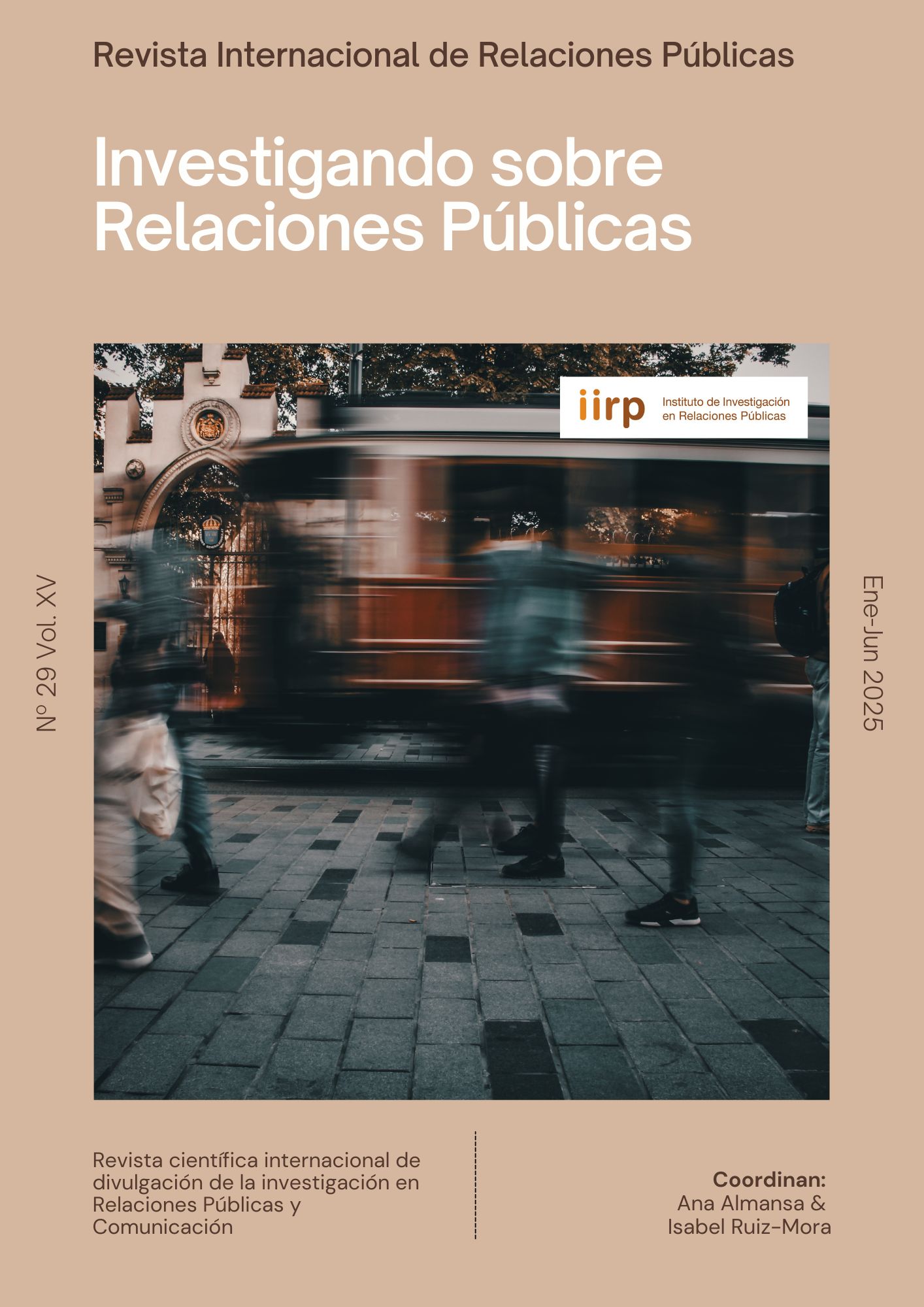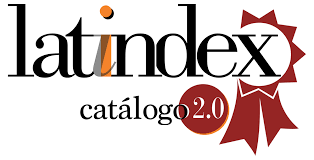Más allá de gustar, compartir y comentar: performance de las Fuerzas Armadas de Cabo Verde en Facebook
DOI:
https://doi.org/10.5783/revrrpp.v15i29.902Palabras clave:
Fuerzas armadas, Cabo Verde, Medios Sociales, Redes sociales, Relaciones Públicas, PerformanceResumen
El presente artículo examina las estrategias de comunicación utilizadas por las Fuerzas Armadas de Cabo Verde (FACV) en su página de Facebook, con el objetivo de comprender su impacto en la opinión pública y la construcción de legitimidad institucional. A través de un enfoque metodológico mixto, se analizaron 129 publicaciones realizadas entre abril y octubre de 2023, combinando análisis cuantitativo de interacciones (13.000 reacciones, 3.000 comentarios) con un análisis cualitativo temático de contenido. Los resultados muestran que las publicaciones relacionadas con acontecimientos trágicos generan mayores niveles de interacción, mientras que los contenidos de alistamiento y comunicación institucional tienen una respuesta más moderada. Las implicaciones del estudio sugieren la necesidad de una gestión estratégica de las redes sociales institucionales, priorizando la planificación editorial y el alineamiento del contenido con los objetivos comunicacionales de la institución.
Descargas
Citas
Adam, M., Wessel, M. & Benlian, A. (2020). AI-based chatbots in customer service and their effects on user compliance, Electronic Markets, 31,427-445. https://doi.org/10.1007/s12525-020-00414-7
Archer, C. (2019). Social media influencers, post-feminism and neoliberalism: How mum Bloggers ‘playbour’ is reshaping public relations. Public Relations Inquiry, 8(2), 149–166. https://doi.org/10.1177/2046147X19846530
Avidar, R. & Roth-Cohen, O. (2023). Social media theory in public relations: A curation of a neglected topic in public relations research. Public Relations Review, 49(5), 102386. https://doi.org/10.1016/j.pubrev.2022.102154
Bardin, L. (1977). Análise de conteúdo. Edições70.
Barros, A. (2020). A Evolução dos Sites de Redes Sociais: uma análise do Facebook. Novatec.
Boatwright, B. & Pyle, A. (2023). “Don’t Mess with Ukrainian Farmers”: An examination of Ukraine and Kyiv’s official Twitter accounts as crisis communication, public diplomacy, and nation building during Russian invasion. Public Relations Review, 49(3), 102338. https://doi.org/10.1016/j.pubrev.2023.102338
Bortree, D.S. & Seltzer, T. (2015). Dialogic Strategies in Social Media: A Study of Nonprofit Organizations' Use of Facebook. Public Relations Journal, 9(2), 1-22.
Boyd, D. & Ellison, N. (2007). Social Network Sites: Definition, History, and Scholarship. Journal of Computer Mediated Communication, 13, 210-230. https://doi:10.1111/j.1083-6101.2007.00393.x
Busquet, J. & Medina-Cambrón, A. (2017). La investigación en comunicación: ¿qué debemos saber? ¿qué pasos debemos seguir? Editorial UOC.
Cabrero, J. & Cabrero, M. (2001). O livro de Ouro das Relações Públicas. Porto Editora.
Capra, F. (2008). Apresentação. In F. Duarte, C. Squant & Q. Souza. O tempo das redes (pp.13-16). Perspectiva.
Castells, M. (2003). A galáxia da Internet: reflexões sobre a internet, os negócios e a sociedade. Jorge Zahar.
Cho, M., Schweickart, T. & Haase, A. (2014). Public engagement with nonprofit organizations on Facebook. Public Relations Review, 40(3), 565-567. http://dx.doi.org/10.1016/j.pubrev.2014.01.008
Coombs, W.T. & Holladay, S.J. (2015). Public relations’ “Relation Identity” in research: Enlightenment or illusion. Public Relations Review, 41(5), 689-695. https://doi.org/10.1016/j.pubrev.2013.12.008
Data Report (2024). Digital 2024 Cabo Verde. In Digital 2024 Global Overview Report, https://datareportal.com/reports/digital-2024-cabo-verde?rq=Cabo%20Verde
Doh, H., Kang, J. & Jo, S. (2024). Empathy in public relations practice of South Korea. Public Relations Review, 50(5), 102506. https://doi.org/10.1016/j.pubrev.2024.102506
Eaton, L. (2007). Army’s Accession Command in an interview with ABC News. “Army’s newest Recruiting Tool: YouTube”.
http://abclocal.go.com/wtvd/story?section=news/national_world&id=5154815
Fearn-Banks, K. (2017). Crisis Communication: a casebook approach. Routledge.
Fernandes, G. (2002). A dilução da África: Uma interpretação da saga identitaria caboverdiana no panorama politico (pós)colonial. Editora de UFSC.
Gil, A.C. (2018). Como Elaborar Projetos de Pesquisa. Editora Atlas S.A.
Grunig, J. & Hunt, G. (1984). Managing Public Relations. Holt, Rinehart & Winston.
Grunig, J. & Hunt, G. (1992). Excellence in Public Relations and Communication Management. Routledge. https://doi.org/10.4324/9780203812303
Groulx, E.J.G. (2015). Use of Social Media in the Canadian Armed Forces Primay Reserves- Facebook- “Friend or Foe?”. Master dissertation, Canadian Forces College, Canada. https://www.cfc.forces.gc.ca/259/290/296/286/groulx.pdf
Holmgreen, L-L. (2024). “We’re not proud of the cases we’ve been involved in”: Crisis resolution on Facebook using conversational human voice. International Journal of Business Communication, 62(1), 70-91. https://doi.org/10.1177/23294884231200861
Huang, M. & Ki, E-J. (2023). Protecting organizational reputation during a para-crisis: The effectiveness of conversational human voice on social media and the roles of construal lever, social presence and organizational listening. Public Relations Review, 49(3), 102389. https://doi.org/10.1016/j.pubrev.2023.102389
Hyman, H. (1971). Diseño y análisis de encuestas sociales. Amorrurtu Editores.
Jayakumar, M., Soundarraj, P.I., Priya, V.P.M., Gupta, R., Abbas, J. & Naser, S.J. (2024). Utilizing Artificial Intelligence-Powered Chatbots for Enhanced Customer Support in Online Retail. 2024 Ninth International Conference on Science Technology Engineering and Mathematics (INCONSTEM): 1-6.
Jenkins, H. (2006). Convergence culture. New York University Press.
Kelleher, T. (2009). Conversational voice, communicated commitment, and public relations outcomes in interactive online communications. Journal of Communication, 59(1), 172-188. https://doi.org/10.1111/j.1083-6101.2006.00019
Kent, M. & Taylor, M. (2002). Toward a dialogic theory of public relations. Public Relations Review, 28(1), 21-37. https://doi.org/10.1016/S0363-8111(02)00108-X
Kent, M. (2010). Directions in social media for professionals and scholars. The Sage handbook of public relations, 2, 643–656.
Kent, M.L. & Li, C. (2020). Toward a normative social media theory for public relations. Public Relations Review, 46(1), 101857. https://doi.org/10.1016/j.pubrev.2019.101857
Kim, C. & Yang, S-U. (2017). Like, comment, and share on Facebook: How each behavior differs from the other. Public Relations Review, 43(2), 441-449. http://dx.doi.org/10.1016/j.pubrev.2017.02.006
Kim, S. & Park, H. (2023). The impact of social media communication on public trust in organizations: A case study of government agencies. International Journal of Public Administration, 46(5),453-465. https://doi.org/10.1080/01900692.2023.2171548
Krippendorff, K. (2004). Content analysis: an introduction to its methodology. London: Sage.
Lawson, S. (2014). The US military's social media civil war: technology as antagonism in discourses of information-age conflicts. Cambridge Review of International Affairs, 27(2),226-245. https://doi.org/10.1080/09557571.2012.734787
Lee, H. & Alhabash, S. (2025). The role of social media influencers in nation branding and relationship building with foreign audiences. Public Relations Review, 51(2), 102570. https://doi.org/10.1016/j.pubrev.2025.102570
Lobban, R.A. (2018). Cape Verde: Crioulo colony to independent nation. Routledge.
Lu, J., Zhang, Y., & Daugherty, T. (2021). Engagement in social media: The role of social media marketing and social media use in building relationships with customers. Journal of Marketing Theory and Practice, 29(2), 155-169. https://doi.org/10.1080/10696679.2021.1888253
Macnamara, J. & Zerfass, A. (2012). Social media communication in organizations: The challenges of balancing openness, strategy, and management. International Journal of Strategic Communication, 6(4), 287–308. https://doi.org/10.1080/1553118X.2012.711402
Macnamara, J. (2016). Organizational listening: Addressing a major gap in public relations theory and practice. Journal of Public Relations Research, 28(3-4), 146-169. https://doi.org/10.1080/1062726X.2016.1228064
Madeira, J.P. (2014). O processo de construção da identidade e do estado-nação em Cabo Verde. Revista Científica Vozes dos Vales, 6(III), 1-23.
Madeira, J.P. (2015). Nação e identidade: a singularidade de Cabo Verde. PhD Thesis, Instituto Superior de Ciencias Sociais e Políticas, Universidade de Lisboa, Portugal.
McCorkindale, T. & DiStaso, M.W. (2014). The state of social media research: Where are we now, where we were and what it means for public relations. Research Journal of the Institute for Public Relations, 1(1), 1–17. https://instituteforpr.org/state-social-media-research-now-means-public-relations/
Minayo, M.C.d.S. (2001). O desafio da pesquisa social. In M. C. S. Minayo (Org.). Pesquisa Social. Teoria, método e criatividade (pp.9-29). Vozes.
Mineiro, P. (2010). As Redes Sociais e a sua Utilização pela Força Aérea Portuguesa. (I. d. Militares, Ed.) Boletim Ensino e Investigação, 155-187.
Mislove, A.E. (2009). On Line Social Networks: Measurement, Analysis, and Applications to Distributed Information Systems. Rice University.
Morsi, S. (2023). Artificial Intelligence in Electronic Commerce: Investigating the Customers’ Acceptance of Using Chatbots. Journal of Systems and Management Sciences, 13(3), 156-176. https://doi.org/10.33168/jsms.2023.0311
Muralidharan, S., Rasmussen, L., Patterson, D. & Shin, J-H. (2011). Hope for Haiti: An analysis of Facebook and Twitter usage during the earthquake relief efforts. Public Relations Review, 37(2), 175-177. https://doi:10.1016/j.pubrev.2011.01.010
Nakara, A., Jaouen, A. & Benmoussa, F.Z. (2012). Entrepreneurship and social media marketing: Evidence from French small business. International Journal of Entrepreneurship and Small, 16(4), 386-405. https://doi.org/10.1504/IJESB.2012.047608
Neto, O.T. (2017). Métodos e técnicas de pesquisa. Argos.
Olsson, E.K., Deverell, E., Wagnsson, C. & Hellman, M. (2016). EU armed forces and social media: convergence or divergence? Defence Studies, 16(2), 97-117. https://doi.org/10.1080/14702436.2016.1155412
Paul, M.J. (2001). Interactive disaster communication on the Internet. Journalism and Mass Communication Quarterly, 78(4), 739–753. https://doi.org/10.1177/107769900107800408
Perry, C. (2010). Social Media and the Army. Militar Review, 90, 63-67. https://apps.dtic.mil/sti/tr/pdf/ADA519943.pdf
Reporters Without Borders (2024). 2024 World Press Freedom Index – Journalism under political pressure. https://rsf.org/en/2024-world-press-freedom-index-journalism-under-political-pressure?data_type=general&year=2024
Robson, P. & James, M. (2013). Not everyone’s aboard the online public relations train: The use (and non-use) of social media by public relations practitioners. PRism, 9(1), 1-18. https://www.prismjournal.org/uploads/1/2/5/6/125661607/v9-no1-a10.pdf
Santos P.M.S. C. dos (2015). Utilização das redes sociais online pelas Forcas Armadas Portuguesas enquanto instrumento de comunicação institucional. Master dissertation, Academia Militar Portuguesa, Portugal. https://comum.rcaap.pt/handle/10400.26/11367
Saxton, G.D. & Waters, R.D. (2014). What do stakeholders like on Facebook? Examining public relations reactions to nonprofit organizations’ informational, promotional, and community-building messages. Journal of Public Relations Research, 26, 280–299. https://doi.org/10.1080/1062726X.2014.908721
Seltzer, T. & Mitrook, M.A. (2007). The dialogic potential of weblogs in relationship building. Public Relations Review, 33(2), 227–229. https://doi.org/10.1016/j.pubrev.2007.02.011
Sweetser, K.D. (2010). A losing strategy: The impact of nondisclosure in social media on relationship. Journal of Public Relation Research, 22(3), 288-212. https://doi.org/10.1080/10627261003614401
Sierra Bravo, R. (1998). Técnicas de investigación social: Teoría e ejercicios. Paraninfo.
Sommerfeldt, E.J., Kent, M.L. & Taylor, M. (2012). Activist practitioner perspectives of website public relations: Why aren’t activist websites fulfilling the dialogic promise? Public Relations Review, 38(2),303–312. https://doi.org/10.1016/j.pubrev.2012.01.001
Statcounter (2025). Social media stats Cape Verde, Jan – Dec 2023. https://gs.statcounter.com/social-media-stats/all/cape-verde/2023
Statistical National Institute from Cape Verde (2021) Censo, 2021. https://ine.cv/censo-2021/
Terra, C. (2009). A comunicação organizacional em tempos de redes sociais online e de usuários-media. In Congresso Brasileiro de Ciências da Comunicação da Região, 32, Curitiba, Brazil, 4-7 september 2009. Curitiba: Intercom Sociedade Brasileira de Estudos Interdisciplinares da Comunicação. http://www.intercom.org.br/papers/nacionais/2009/resumos/R4-0495-1.pdf
Toffler, A. (1980) The third wave. Bantam Books.
Toledano, M. & Avidar, R. (2016). Public relations, ethics, and social media: A crossnational study of PR practitioners. Public Relations Review, 42(1), 161-169. https://doi.org/10.1016/j.pubrev.2015.11.012
Torres, C. (2009). A bíblia do marketing digital. Novatec.
Veil, S.R., Woods, C.L. & Hecht, R.D. (2018). The journalist as the audience: Evaluating the U.S. Navy’s “Sailor for a Day" campaign. Public Relations Review, 44(5),717-723. https://doi.org/10.1016/j.pubrev.2018.08.010
Wahab, H.A. (2023). Exploring the effect of AI Chatbots on customer experience, Satisfaction and Advocacy: New Evidence from the Banking sector in Egypt. Commerce and Finance, 43(2),116-146. https://doi.org/10.21608/caf.2023.303703
Wang, Y., Sheng, Y. & Sun, J. (2021). When public relations meets social media: A systematic review of social media related public relations research from 2006 to 2020. Public Relations Review, 47(4), 102081. https://doi.org/10.1016/j.pubrev.2021.102081
Wasserman, S. & Faust, K. (1994). Social Network Analysis: methods and applications. Cambridge University Press.
Waters, R.D. (2009). The use of social media by nonprofit organizations: An examination from the diffusion of innovations perspective. In T. Dumova & R. Fiordo (Eds.), Handbook of research on social interaction technologies and collaboration software: Concepts and trends (pp.473-475). IGI Publishing.
Waters, R.D., Burnett, E., Lamm, A. & Lucas, J. (2009). Engaging stakeholders through social networking: How nonprofit organizations are using Facebook. Public Relations Review, 35(2),102-106. https://doi.org/10.1016/j.pubrev.2009.01.006
Wellman, B. (1997). An Electronic Group is Virtually a Social Network. In S. Kiesler (Org.) Culture of Internet (pp.179-205). Lawrence Erlbaum.
Wright, D.K. & Hinson, M.D. (2014). An updated examination of social and emerging media use in public relations practice: A longitudinal analysis between 2006 and 2014. Public Relations Journal, 8(2),1-35.
Wright, D. & Hinson, M. (2017). Tracking how social and other digital media are being used in public relations practice: A twelve-year study. Public Relations Journal, 11(1), 1-30.
Wragg, D. (1989). Relações públicas em marketing e vendas: uma abordagem gerencial. McGraw-Hill.
Xu, W. & Saxton, G.D. (2019). The role of social media in nonprofit organizations’ crisis communication: A study of the American Red Cross. Public Relations Review, 45(1), 78-86. https://doi.org/10.1016/j.pubrev.2018.10.004
Descargas
Publicado
Cómo citar
Número
Sección
Licencia
Derechos de autor 2025 Javier Martínez-Ortiz, Alvaro Elgueta-Ruiz, Nádia Fortes

Esta obra está bajo una licencia internacional Creative Commons Atribución-NoComercial-SinDerivadas 4.0.
Los autores que publican en esta revista están de acuerdo con los siguientes términos:- Los autores conservan los derechos de autor y garantizan a la revista el derecho de ser la primera publicación del trabajo al igual que licenciado bajo una Creative Commons Attribution License que permite a otros compartir el trabajo con un reconocimiento de la autoría del trabajo y la publicación inicial en esta revista.
- Los autores pueden establecer por separado acuerdos adicionales para la distribución no exclusiva de la versión de la obra publicada en la revista (por ejemplo, situarlo en un repositorio institucional o publicarlo en un libro), con un reconocimiento de su publicación inicial en esta revista.
- Se permite y se anima a los autores a difundir sus trabajos electrónicamente (por ejemplo, en repositorios institucionales o en su propio sitio web) antes y durante el proceso de envío, ya que puede dar lugar a intercambios productivos, así como a una citación más temprana y mayor de los trabajos publicados (Véase The Effect of Open Access) (en inglés).





